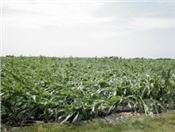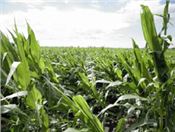|
Storm Damage In Corn
DR. EMERSON NAFZIGER
URBANA, ILL.
High winds hit parts of central and north-central Illinois on June 22 and 23, flattening corn that was at stages V10 to V13 or so (4 to 7 feet tall.) Hail damaged leaf area in some places as well, but hail was not as widespread as wind damage.
Figure 1 shows corn completely flattened at our Monmouth Research & Education Center, following wind gusts up to 78 mph between 2:45 and 3:00 AM on June 22. The detailed weather record indicates that rain started to fall at about that same time, and by 6:00 AM more than 2.5 inches had fallen.
Even though “steamrollered” corn is a disheartening sight, several factors converged to make this much less damaging than we would often see with such events at this time of year and with corn this size. Rainfall during the first half of June has been limited in most of Illinois, and warm temperatures have meant rapid growth and water uptake. This has meant relatively dry surface soils, which has encouraged roots to grow deeper. So the crop was well-anchored by its root system when the wind blew.
As soils have dried out, water uptake has slowed slightly. The crop has been making good growth, but drying soils mean that cells in the stalk take in a little less water. This decreased the internal cell pressure, and so lowers the tendency of plants to snap off at a node – what is called greensnap. Plants of this size and at this stage, when well-watered and growing fast, are often susceptible to greensnap. Such breakage happens at upper (younger) nodes that haven’t yet been strengthened by lignin deposits. Even a slight reduction in the amount of water moving into cells is enough to reduce the potential for greensnap.
The third factor that helped the plants was the sequence of events: wind came first then rain, instead of a lot of rain followed by wind. Soil softened by rain, especially when it’s been wet and roots haven’t grown as deep, allows plants to tip over, pulling part of the root system out of the soil, and allowing plants to lie down flat on the soil. In the photo above, it’s clear that the plants, while nearly parallel to the ground, aren’t flat on the ground like they often are when corn root-lodges.
While the picture based on the event at Monmouth probably is not accurate for some places where this type of damage occurred, I think we will see this crop recover fairly quickly, perhaps with little if any effect on yield. In a study in Wisconsin, the soil was wetted and corn pushed down to the ground, causing root lodging, at different growth stages. They found less than 5 percent yield loss when plants were lodged at stage V10-12 and 9 percent loss when this was done at V12-14.
Root-lodged corn plants will gooseneck (bend towards upright) after lodging, but gradually lose their ability to do this as the stalks become lignified. If plants are only bent over with their roots intact and still in the soil, they will recover faster and better than root-lodged plants. Figure 2 shows corn in the same field as Figure 1, with the photo taken 24 hours later. In fields that didn’t root-lodge, recovery started quickly and is proceeding fast. Moist soil and warm temperatures will speed recovery. In many fields, we dodged a bullet this time.
If hail accompanied storms, as it did at Monmouth, yield loss will be related to the amount of leaf loss, or more accurately, to the decrease in the ability of the crop to intercept sunlight over the next few weeks and after pollination. Those who have hail insurance will have an adjuster evaluate leaf loss and crop stage, and yield loss will be estimated based on the loss chart. Corn is nearing the stage when leaf loss has its maximum effect on yield, but leaf area loss of only 10 or 15 percent, while it looks bad, will affect yield only modestly. With some new leaf area yet to emerge, and with relatively minor leaf damage in most cases reported, losses shouldn’t to large.
Wind along with hail damage may not increase the effect of leaf area loss, but the stalk will need to come back to a more upright position before light interception returns to normal, and leaf loss will extend the recovery time. Stalks of flattened plants may also have taken some direct hits by hail and show some bruising. This can interfere slightly with sugar movement through the leaf sheaths, which could cause some reduction in kernel set. Hail loss adjustment should cover this.
With some leaf area underneath flattened plants and out of reach of fungicides, and with research that shows that that hail-damaged leaves benefit no more than intact leaves from foliar fungicide, there’s little to suggest that fungicide should be applied now. Having leaves near the soil during and after heavy rain could encourage the start of foliar diseases such as gray leaf spot. Scouting for such diseases should, regardless of plant damage, be a high priority as pollination approaches in the coming weeks. ∆
DR. EMERSON NAFZIGER: Research Education Center Coordinator, Professor, University of Illinois

Figure 1. Corn flattened by wind in the early morning of June 22, 2016.
Photo taken in mid-afternoon on June 22 at the Monmouth Research
& Education Center by Angie Peltier.

Figure 2. Corn flattened by wind in the early morning of June 22, 2016.
Photo taken about 24 hours after the photo in Figure 1, and in the same field.
Photo by Angie Peltier.
|
|